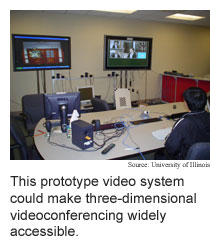
December
5, 2005
3D
video for the rest of us
Now that digital cameras are a dime a dozen, it's no longer far-fetched
to imagine the average person installing a dozen digital cameras to support
three-dimensional videoconferencing. Today's computer processors and displays
will also support tele-immersive environments. Handling and transporting
all that time-sensitive data, however, is still a stretch for ordinary
desktop operating systems and the Internet.
 Researchers from the University of Illinois at Urbana-Champaign and the
University of California at Berkeley have developed software, dubbed Tele-immersive
Environments for EVErybody (TEEVE), that aims to bridge this gap.
Researchers from the University of Illinois at Urbana-Champaign and the
University of California at Berkeley have developed software, dubbed Tele-immersive
Environments for EVErybody (TEEVE), that aims to bridge this gap.
The system captures and coordinates video streams from three or
more sets of four cameras, each of which generates a stream of three-dimensional
video data. The system generates macro video frames made up of the frames
from all of the cameras at one time interval, and sends them over a network
in a way that evenly distributes the data so that it does not overload
the network.
The system could make three-dimensional videoconferencing more
affordable.
(TEEVE: The Next Generation Architecture for Tele-immersive Environments,
IEEE International Symposium on Multimedia, Irvine, California, December
12-14, 2005)
Infectious antivirus protection
One way to curb computer viruses is to beat them at their own
game.
Researchers from Hebrew University and Tel Aviv University in
Israel and the Institute for Scientific Interchange (ISI) in Italy have
showed
that a good way to defeat computer viruses is to make immunization software
that spreads like viruses.
The researchers' scheme uses traps, dubbed honey pots, that are
spread across the Internet and become infected as a virus spreads. The
traps analyze the virus, generate immunization software and spread the
immunization code across the network. To ensure that the immunization
code spreads faster than the virus, the system uses special links that
only carry the immunization code.
The system is one of several ongoing efforts to develop the equivalent
of an immune system for the Internet. Current immunization strategies
require individuals to protect their own computers -- by all accounts
an inefficient and burdensome approach.
(Distributive Immunization of Networks against Viruses Using the
'Honey-Pot' Architecture, Nature Physics, December, 2005)
Energy-free communications
According to the laws of physics, you have to expend energy to
communicate. It turns out, though, that you don't have to send that energy
to the other party. This is useful because communications that happen
without sending energy to another party are theoretically impervious to
eavesdroppers.
A study by
a Texas A&M University researcher shows that two parties can communicate
without putting energy into the communications channel by modulating and
monitoring the channel's natural noise.
In ordinary communications, signals are transmitted using light
or electricity. In contrast, the researchers' scheme uses ever present
temperature fluctuations or zero-point energy. Zero-point energy consists
of virtual particles like photons that pop in and out of existence in
a vacuum. Because eavesdropping on such a signal either alters the characteristics
of the noise in the channel or throws off the timing of signals, it is
always possible to detect any eavesdroppers.
The method could eventually be used to provide potentially perfectly
secure communications.
(Stealth Communication: Zero-Power Classical Communication, Zero-Quantum
Quantum Communication and Environmental-Noise Communication, Applied
Physics Letters, December 5, 2005)
A motivated room
Intelligent rooms aim to track movement, recognize gestures and
understand spoken commands in order to control lights, project information
on the walls and tell you who called while you were out.
The complicated collections of equipment involved -- computers,
cameras, pressure sensors, projectors, microphones -- can be tricky to
coordinate and calibrate, however. Intelligent rooms will never be practical
if they require a team of technicians to adjust them every time someone
moves a camera or behaves in a way the room doesn't expect. With this
in mind, many teams of researchers are working on giving intelligent environments
the ability to learn and adapt.
Researchers from the University of Sydney in Australia have come
up with a scheme
that uses artificial intelligence software dubbed intrinsically motivated
learning agents to make intelligent environments more intelligent. Agents
are autonomous pieces of software that can react to and affect their digital
environments. Intrinsically motivated learning agents reward themselves
for making discoveries.
In the initial tests of learning agent-enabled intelligent rooms
the rooms learned to associate different behaviors with people's locations,
which shows they are capable of learning patterns of use. The researchers
have not yet tested the system's ability to adapt to changes in equipment.
(Intrinsically Motivated Intelligent Rooms, Second International
Symposium on Ubiquitous Intelligence and Smart Worlds, Nagasaki, Japan,
December 6-7, 2005)
Bits and pieces
A microfluidic bubble blower shows the way complex
behavior emerges from simple environments; genetically engineered
bacteria form biological
photographic film; silicon nanowires are grown with chemically-altered
regions that promise small, easy-to-manufacture computer circuits.
RSS Feeds: News Blog Books New: TRN's Internet Services TRN's Jobs Center News: Research News Roundup Research Watch blog Features: View from the High Ground Q&A How It Works Buy an ad link |
|
| Advertisements: |
|
Ad links: Clear History
Buy an ad link
|
TRN
Newswire and Headline Feeds for Web sites
|